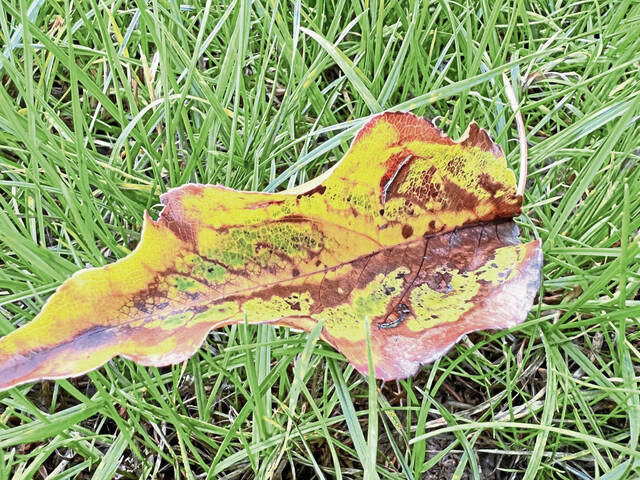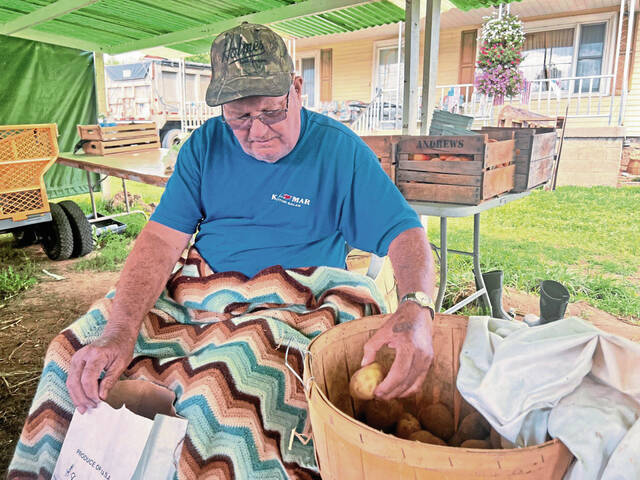Fall foliage enthusiasts can expect a less vibrant leaf-peeping fall this year in Western Pennsylvania, according to area experts.
Certified arborist Eric Countryman of Swissvale has studied trees for 15 years. He said this year’s record-breaking heat and lack of rain across Western Pennsylvania will likely result in trees turning colors and dropping their leaves sooner.
“If you’re seeing leaves turning color now, it would be much too soon, and it could be environmental, due to drought and heat,” said Countryman, district manager for the East Pittsburgh office of Davey Tree. He has a degree in biology from Case Western Reserve University and received his arborist certification from the International Society of Arboriculture.
Factors such as diseases, insects, drought, heavy rain and heat can contribute to leaves turning and dropping earlier.
In Western Pennsylvania, the normal time frame for trees to turn colors is mid-September through October, but trees are already experiencing color changes and dropped leaves as of Wednesday in the communities of Gilpin, Leechburg and Lower Burrell.
This year, the first day of fall is Sunday, Sept. 22, according to the National Weather Service.
Countryman described this year’s summer weather patterns as “strange.”
“This can stress trees. The months of May, June and July were very low on rain and in the 90s and not normal for Western Pennsylvania.”
This can lead to a stressed tree shedding its leaves early to reduce its leaf load.
Homeowners can assist their trees by watering them weekly underneath the drip line (where branches are) and adding mulch at the base of the tree.
“Wood chips or bark is the best mulch and it should be spread underneath the canopy about three inches thick to protect the root zone,” Countryman said.
In nature, cooler temperatures combined with ample rainfall help a tree hold its leaves.
A dry summer results in less vibrant foliage.
“It’s hard to say this early, but from the looks of it, I’m not expecting a particularly vibrant fall this year,” Countryman said.
Fourth-generation farmer Ralph Myers has more than 50 years of experience toiling the soil on his family farm in Gilpin, Armstrong County.
Myers sat underneath a blanket outside Wednesday packaging potatoes and lamented the dry conditions this growing season, and how that may usher in an early fall season.
This week a brief cooldown ushered in nighttime temps in the 50s, unusual for August, but temperatures are forecasted to jump back up to the 80s and 90s for the rest of the week, with no significant rain in the forecast.
“There’s a good chance of it. Spring was early this year. The ground never froze so fall may come early,” Myers said. “It’s been extra dry this year.”
The 2024 Old Farmer’s Almanac predicts a cooler-than-average fall and slightly earlier peak of color, by Oct. 11.
Autumn colors are expected to be on display in the entire Laurel Highlands region in mid-October, according to USA Today.
Pennsylvania has a longer fall foliage season than anywhere else in the world and is one of three regions globally that supports deciduous forests that display fall autumn color, according to the Pennsylvania Department of Conservation and Natural Resources.
More than 16 million acres of forests exist in Pennsylvania and the Laurel Highlands region boasts 134 species of trees that make for spectacular fall foliage viewing opportunities.
View the Old Farmer’s Almanac interactive fall foliage map at almanac.com.
Joyce Hanz is a native of Charleston, S.C. and is a features reporter covering the Pittsburgh region. She majored in media arts and graduated from the University of South Carolina. She can be reached at jhanz@triblive.com





